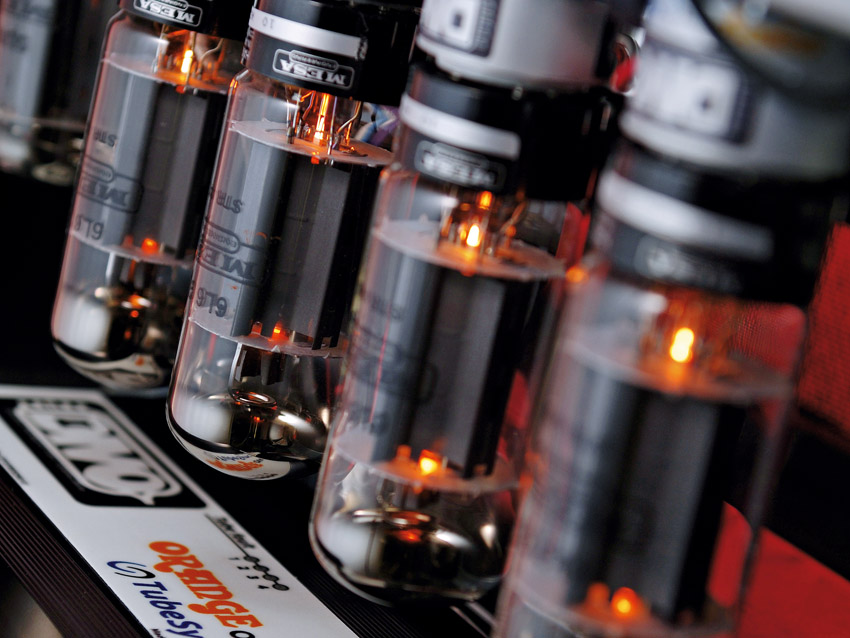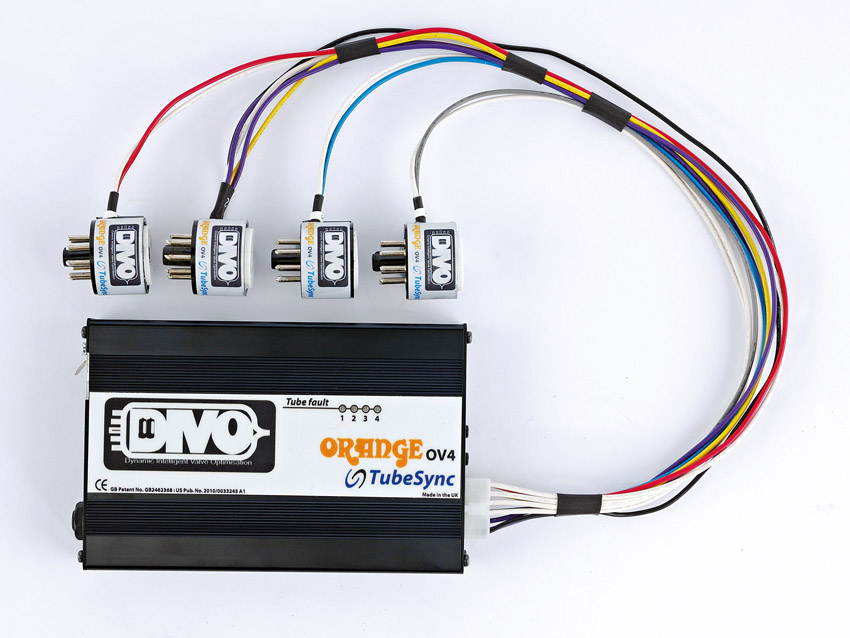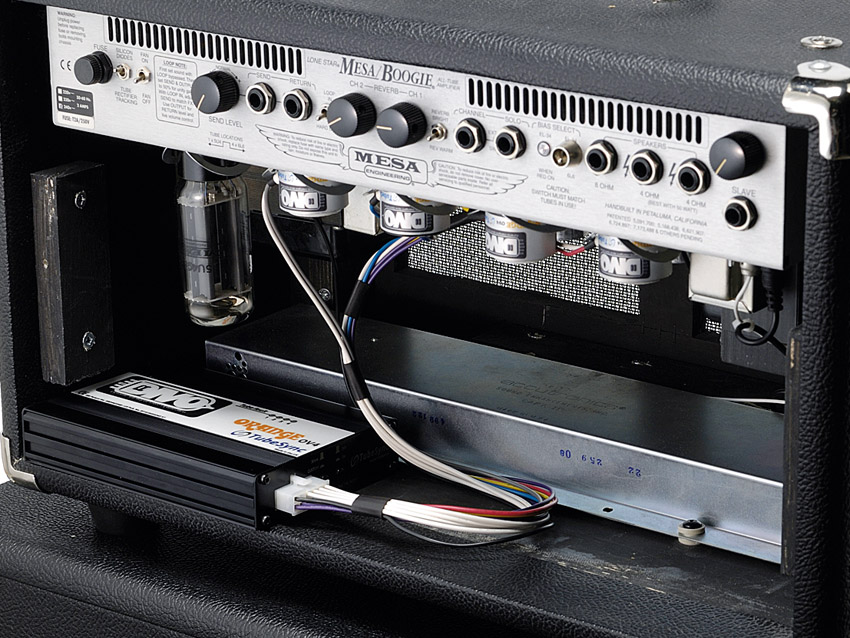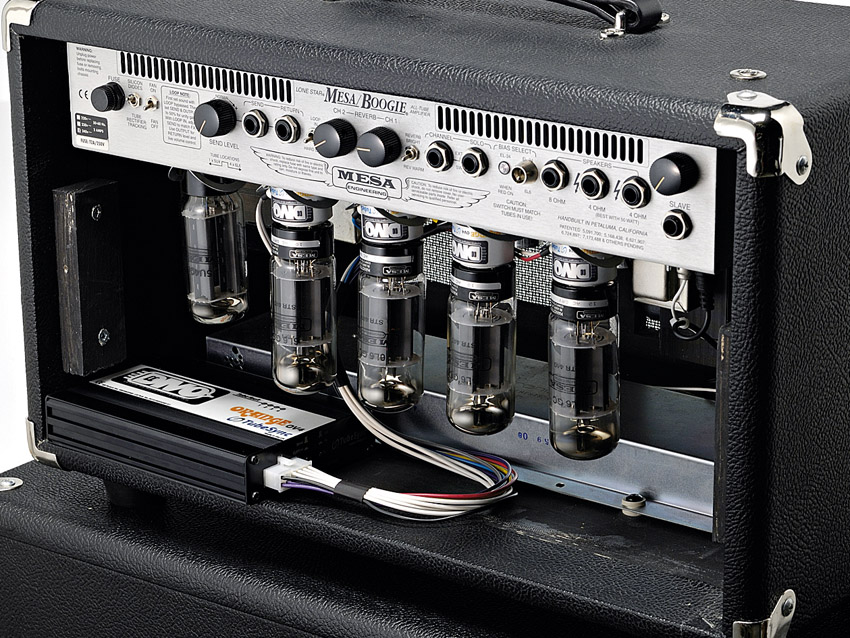MusicRadar Verdict
A brilliant idea from the UK that could be the way of the future for valve amp design.
Pros
- +
The DIVO OV4 made a noticeable improvement to our amp, even with a brand new matched quartet.
Cons
- -
It's a pity the interface and configuration software isn't generally available to the public, although there are sound reasons for that.
MusicRadar's got your back

Orange TubeSync DIVO OV4

Orange TubeSync DIVO OV4

Orange TubeSync DIVO OV4

Orange TubeSync DIVO OV4
Bias, and how to set it, is probably one of the most contentious issues for many valve amp users, especially those who like to tweak their amp by installing different makes or types of output valve.
Put simply, bias is your valve's idle adjustment - it's like making sure your car is ticking over properly. In fixed bias amplifiers, this is achieved by applying a negative voltage to the valve's control grid - literally a grid of wire that sits between the cathode and plate.
"Once set, the OV4 continually micro-adjusts the bias current for each individual valve, keeping the amp running at peak efficiency."
When you switch your amp on, electrons are generated at the cathode and pulled towards the plate, causing current to flow. This happens because electrons are negatively charged particles and the plate is energised with a strong positive voltage - opposite poles attract.
Varying the control grid's negative voltage means this flow of electrons can be slowed to a trickle, or even stopped - like poles repel.
Although people often refer to the negative bias voltage setting, it's the actual idle current that is important. All valves have an ideal idle current, typically around 30-50 milliamps, and for the amp to operate at its best it's important that all your output valves are idling equally.
This is done by fitting valves that have been matched in pairs or quartets, however even the best matching doesn't mean that valves will wear equally, so in order to keep your amp operating at its best, an occasional small adjustment to the bias is sometimes necessary.
Usually these adjustments are at best a compromise; as individual output valves rarely draw the same idle current. What if there was a device that could measure and automatically adjust the bias for each individual valve? Well now there is: the Orange/TubeSync DIVO, which stands for Dynamic Intelligent Valve Optimisation.
It's been available in OEM format for some time, however retrofitting this to an existing amp isn't easy and is definitely beyond most guitarists' capabilities. What was needed was a simple, bolt-on accessory that can be added to any fixed bias amp, and that's what Orange has now come up with, in the shape of the DIVO OV4.
Built into an aluminium case about the size of a small paperback, the OV4 module comes with both a bracket and strong industrial Velcro fixings. Four piggyback octal sockets, or interceptors as Orange calls them, are connected to a strong nylon multi-pin plug that is located at one end of the module.
There are two small push-button switches, one offering a choice of standard and custom bias settings, while the other is called 'share the wear'. At the other end of the module there's an earth connection, together with an RJ45 socket and a standard 6mm jack socket.
The RJ45 socket is where the DIVO OV4's interface module plugs in, allowing the product to be configured and interrogated from a PC using a small Windows-compatible program. This handy software lets authorised resellers/installers configure the custom bias switch setting, either globally or for each valve individually, as well as a second 'idle only' bias current that operates as a progressive standby feature.
Once set, the OV4 continually micro-adjusts the bias current for each individual valve, keeping the amp running at peak efficiency. It also means that you can run any combination of standard octal power valve you like, although pairs, such as 6L6s and EL34s are more useful.
With no audio present, the OV4 can automatically drop the bias current to a lower setting to reduce wear and tear, instantly returning to its higher level when audio is detected.
In the event of a valve fault, a clever algorithm shuts off the affected pair automatically and remembers which valves are at fault, displaying them on warning LEDs, as well as in the software, while also keeping a record of how many hours use the amp has had, both with and without audio.
The jack socket connects to a standard footswitch letting you switch the amp from full power (all four valves on) to half power, moreover the 'share the wear' function remembers which pair of valves were switched off the last time and alternates them, keeping wear as even as possible, although if you use two different pairs of valves, such as 6L6s and EL34s, you can use this as a tone option, swapping from one pair to the other. Cool or what?
In Use
Installing the OV4 on an unmolested 1970s Marshall 100-watt Super Lead head, we deliberately plug in an assortment of unmatched power valves - an EL34, a 6V6, a 6L6 and a 6550.
Setting the custom bias measurements for each valve in the DIVO's software, we use a special piggyback test socket connected to a multimeter to verify the DIVO does actually do what it says on the can - needless to say, it does.
We then install an old set of EL34s and compare these results with a brand new matched quartet of Groove Tubes - the OV4 automatically senses the difference, easily dealing with big variations across the old valves and smaller ones on the new set.
Sonically, the OV4 noticeably tightens up the Super Lead's midrange focus and attack while also slightly reducing mains hum, indicating that the magic DIVO box is actually making a positive improvement to the amp's performance.
For owners of most fixed bias four-valve amps, DIVO offers a reliable and simple means of ensuring peak operation at all times; it works efficiently and transparently and should extend the working life of valves way beyond the point when most people would start thinking about replacement.
There was a time when all cars used a mechanical device called a carburettor to spray fuel into the engine - mechanics had to adjust them by hand, using a plethora of vacuum gauges, stethoscopes and experience to get the best results.
Today, this dark art has been replaced by the convenience and reliability of electronic fuel injection and engine management - if your mechanic wants to know what's happening inside your engine he doesn't make intelligent guesses any more, he plugs in a laptop instead and the car tells him what's wrong.
The DIVO OV4 is really like engine management for your valve amp. It's ready-fitted to the Orange Rockerverb 100, meanwhile this retrofit version is quick and easy for authorised installers to fit to almost any four-valve design.
As there's presently no competition, it's difficult to make comparisons, but we think the price is pitched just about right. Those who like to tweak things may be frustrated that the PC interface and diagnostic software isn't available to the general public, however there is the possibility of damaging your amp if it isn't configured properly, so this is an entirely sensible decision.
DIVO works perfectly and does an excellent job of keeping even the most wayward valves on the straight and narrow. If you want to get the absolute best out of your amp and improve its reliability, DIVO is almost an essential - it's a real innovation.
“Built from the same sacred stash of NOS silicon transistors and germanium diodes, giving it the soul – and snarl – of the original”: An octave-fuzz cult classic returns as Jam Pedals resurrects the Octaurus
What’s the buzz? Meet Yellowjacket, Cherry Audio's recreation of EDP’s trend-setting Wasp from 1978
“A fabulous trip through all eight songs by 24 wonderful artists and remixers... way beyond anything I could have hoped for”: Robert Smith announces new Cure remix album









